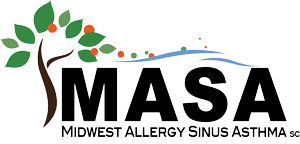Food Allergies
Midwest Allergy Sinus Asthma, SC
If you have gotten sick or experienced hives, sneezing, swelling, or other symptoms of allergies after eating, you may have food allergies. New food allergies are scary and bewildering, but Midwest Allergy Sinus Asthma, SC, with locations in Normal and Springfield, Illinois, is ready to help you navigate. Come to Midwest Allergy Sinus Asthma for allergy testing, allergy immunotherapy, and help you to better manage your allergy. To get started, call or use the online booking tool today.
Food Allergies Q & A
How do food allergies work?
Food allergies occur when your immune system incorrectly identifies a food protein as a threat, it overreacts and attacks it.
The top eight food allergens in the United States are:
- Milk
- Egg
- Peanuts
- Tree nuts
- Soy
- Wheat
- Fish
- Shellfish
In addition, corn and sesame seed allergies are becoming more common in the U.S.
What are some food allergy symptoms?
If you’ve consumed or come in contact with food to which you’re allergic, you may have one or more of the following symptoms:
- Itching
- Runny nose
- Hives
- Nausea
- Vomiting
- Wheezing
- Food-induced eczema
- Food-induced asthma
- Mouth and tongue swelling
- Dizziness
- Blood pressure changes
- Low blood pressure
- Anaphylaxis
Some food allergies and food intolerances cause headaches, brain fog, and digestive problems like irritable bowels, bloating, and gastroesophageal reflux (GERD).
How does food allergy testing work?
Your allergist at Midwest Allergy Sinus Asthma typically tests you for food allergies using the skin-prick test.
They begin allergy testing by placing small drops of potential allergenic solutions onto your forearm or back. They mark each spot so they know what they place where. Then, they gently prick or scratch your skin with a needle or small plastic probe.
By pricking your skin, they allow just a tiny amount of each potential allergen to enter your body under the skin. Then, they wait for about half an hour to see the results. During that time, if you’re allergic to any of the substances, your skin will develop a wheal at that spot. A wheal is a raised, white bump encircled by angry, red skin.
This prick allows a tiny amount of each allergen to enter your body just below the surface of your skin. Within 30 minutes, if you have an allergy, your skin will react with a wheal. If your skin doesn’t react with a wheal, you’re probably not allergic to a given substance.
If you have no reaction a certain substance, it’s extremely unlikely that you’re allergic to it. False negative skin tests are very rare. False positives are far more common.
If you’re trying to determine whether your positive results are accurate, or you can also undergo an oral food challenge, a medical food challenge during which you slowly introduce more and more of the allergen in question, to see if you react to it.
How can I treat my food allergies?
There is no cure for food allergies, and the best way to stay safe is to fill out an anaphylaxis action plan. This is an outline that maps out symptoms and their severity, lists your allergies and medications, and your emergency contact info. It helps others help you in case of a life-threatening emergency.
Midwest Allergy Sinus Asthma team also offers oral immunotherapy (OIT) for food desensitization. During OIT, your allergist feeds you a small amount of your allergen via sublingual food drops in at the office.
Every time you see them, they increase the dose. The goal of this is to increase your immune system’s tolerance for the allergen (food tolerance induction) and raise the threshold that could trigger a reaction.
Note that, even with successful food allergy treatment, you should still carry your EpiPen for anaphylaxis emergencies.
Food allergies aren’t a death sentence; you can live a full, meaningful life while managing them. To learn more, schedule an appointment with Midwest Allergy Sinus Asthma online or over the phone today.
